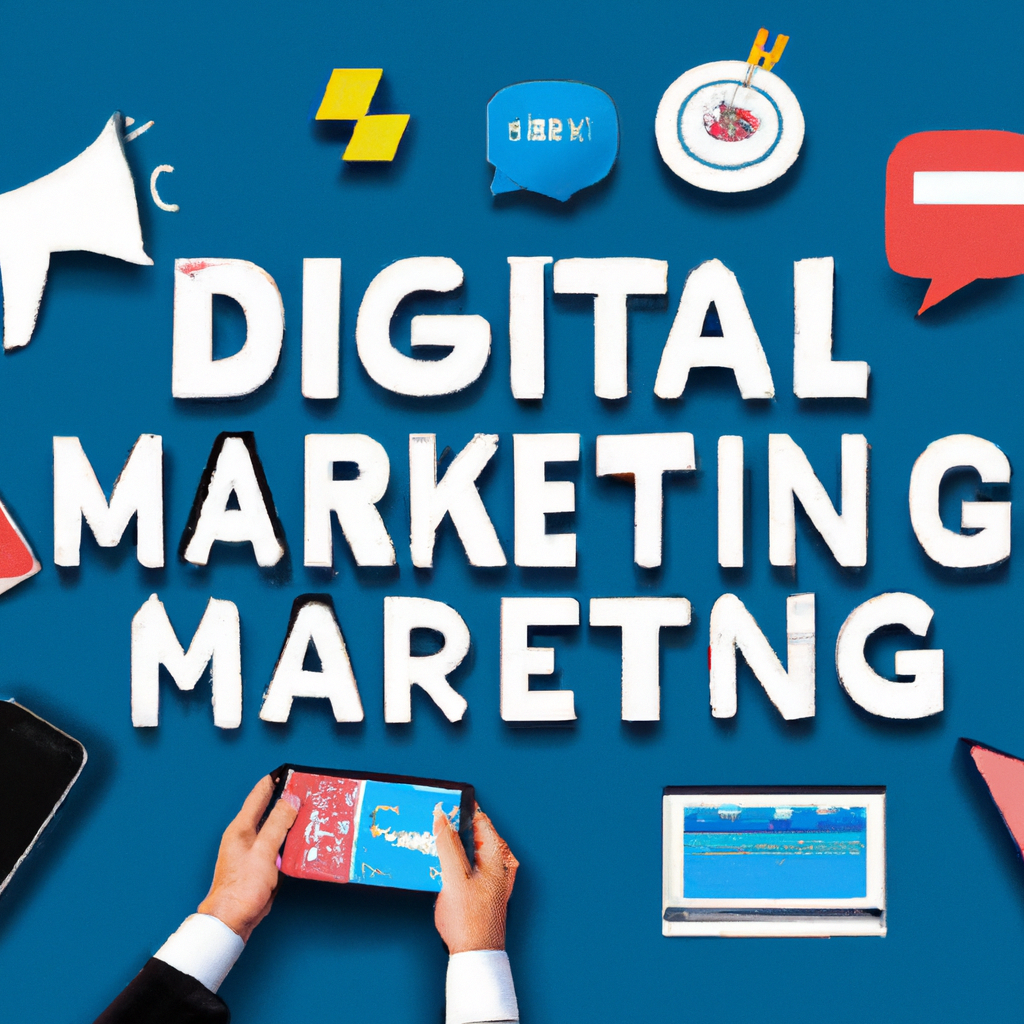Starting a new business can be exciting, but it also comes with its fair share of challenges. In a world where digital presence is crucial for success, it is essential for startups to implement effective digital marketing strategies. From building a strong online presence to utilizing social media platforms, there are several tried and tested methods that can help startups thrive in the competitive market. This article will explore some of the best digital marketing strategies that startups can adopt to achieve their goals and reach their target audience effectively.
Search Engine Optimization (SEO)
Keyword Research
Keyword research is the foundation of any successful SEO strategy. It involves identifying the most relevant and high-performing keywords related to your business and target audience. By conducting thorough keyword research, you can optimize your website’s content and meta tags to increase your visibility in search engine results.
On-page SEO
On-page SEO refers to the optimization techniques that are implemented directly on your website. This includes optimizing your title tags, meta descriptions, headings, and page content with relevant keywords. Additionally, on-page SEO involves improving your website’s loading speed, mobile-friendliness, and URL structure. These factors contribute to better user experience and search engine rankings.
Off-page SEO
Off-page SEO encompasses strategies that are implemented outside of your website to enhance its online visibility. This includes building high-quality backlinks from reputable and relevant websites, engaging in guest blogging and influencer collaborations, and leveraging social media to share and promote your content. Off-page SEO helps search engines recognize the authority and credibility of your website, ultimately improving your rankings.
Technical SEO
Technical SEO focuses on optimizing the technical aspects of your website to enhance its visibility and crawlability for search engines. This includes optimizing your site’s XML sitemap, robots.txt file, and site architecture. Technical SEO also involves improving website loading speed, ensuring proper indexing of your webpages, and implementing structured data markup. By addressing these technical aspects, you can enable search engines to efficiently crawl and understand your website’s content.
Social Media Marketing
Choosing the Right Platforms
When it comes to social media marketing, it’s essential to choose the right platforms that align with your target audience and business goals. Conduct research to identify which social media channels your audience frequents the most. Whether it’s Facebook, Instagram, Twitter, LinkedIn, or others, selecting the right platforms allows you to direct your efforts towards engaging with your desired audience effectively.
Creating Engaging Content
The success of your social media marketing efforts relies on creating and sharing content that captures the attention and interest of your followers. Be creative and informative, offering valuable insights, industry news, and entertaining content. Use eye-catching visuals, videos, and infographics to enhance engagement. Be sure to respond to comments and messages promptly to encourage interaction and build a loyal community.
Paid Advertising
Paid advertising on social media platforms can help amplify your reach and target specific segments of your audience. Platforms like Facebook Ads, Instagram Ads, and LinkedIn Ads provide advanced targeting options based on demographics, interests, and behaviors. By allocating a budget for paid advertising, you can promote your content, products, or services to a wider audience and increase brand awareness.
Influencer Marketing
Influencer marketing involves partnering with individuals who have a significant following and influence in your industry. These influencers can promote your products or services to their audience through sponsored posts, reviews, or collaborations. By leveraging their credibility and reach, you can gain exposure to a wider audience and potentially drive more traffic, leads, and conversions to your business.

Content Marketing
Creating Valuable Content
Content marketing focuses on creating and sharing valuable, informative, and relevant content to attract and engage your target audience. By providing content that addresses their pain points, answers their questions, and offers solutions, you can establish yourself as a trusted authority in your industry. Valuable content can come in various forms, including blog articles, whitepapers, eBooks, videos, podcasts, and more.
Blogging
Maintaining a blog is a powerful content marketing strategy that allows you to consistently provide fresh and engaging content to your audience. Blogging helps you showcase your expertise, attract organic traffic from search engines, and establish thought leadership in your industry. When blogging, incorporate relevant keywords strategically and encourage reader engagement through comments and social sharing.
Guest Blogging
Guest blogging involves writing and publishing articles on other reputable websites within your industry. This helps you tap into new audiences, gain exposure, and build backlinks to your website. Look for relevant websites that accept guest blog submissions and contribute well-written and informative articles. This not only helps expand your reach but also enhances your website’s authority in the eyes of search engines.
Email Marketing
Email marketing remains a highly effective strategy for engaging with your audience and nurturing leads. By building an email list, you can send targeted and personalized content directly to your subscribers’ inboxes. This can include newsletters, promotional offers, educational content, and more. Utilize email marketing automation to send automated follow-up sequences, segment your audience based on their interests, and personalize your messages for better engagement.
Pay-per-Click (PPC) Advertising
Google Ads
Google Ads is a powerful platform that allows you to create and run pay-per-click (PPC) advertising campaigns on the Google search engine and its advertising network. By bidding on relevant keywords, you can display text-based ads at the top of search engine results, targeting users actively searching for your products or services. Google Ads offers advanced targeting options, tracking capabilities, and the ability to set a budget that suits your needs.
Facebook Ads
Facebook Ads provides extensive targeting options and a massive user base, making it an ideal platform for reaching your target audience. From creating brand awareness campaigns to driving website traffic and conversions, Facebook Ads offers multiple ad formats, including images, videos, and carousels. Utilize Facebook’s targeting capabilities to select specific demographics, interests, and behaviors to ensure your ads reach the right people.
LinkedIn Ads
LinkedIn Ads is a valuable platform for businesses targeting professionals and B2B marketing. LinkedIn allows you to create sponsored content, text ads, and message ads to reach your ideal audience based on job titles, industries, company size, and more. With LinkedIn Ads, you can promote thought leadership content, target decision-makers, and generate high-quality leads in a professional context.
Remarketing
Remarketing, also known as retargeting, involves displaying targeted ads to users who have previously visited your website or engaged with your brand. By using website cookies, remarketing allows you to re-engage with these users as they browse other websites or use social media platforms. Remarketing can help increase brand recall, improve conversion rates, and encourage users to complete their desired actions.

Email Marketing
Building an Email List
Building an email list is crucial for a successful email marketing campaign. Offer valuable incentives such as exclusive content, discounts, or free resources to entice visitors to subscribe to your mailing list. Utilize opt-in forms, landing pages, and lead generation tools to capture relevant contact information and expand your email list.
Segmentation
Segmentation involves categorizing your email list based on specific criteria such as demographics, interests, location, or purchase behavior. By segmenting your list, you can send more targeted and relevant content to different groups of subscribers. This ensures that your emails resonate with their interests and needs, leading to higher engagement and conversion rates.
Personalization
Personalization is a powerful email marketing technique that involves tailoring your emails to each individual subscriber. By using merge tags and dynamic content, you can address subscribers by name, provide customized recommendations, and personalize discounts or offers based on their past interactions. Personalization creates a more personalized and engaging experience, ultimately boosting open rates and click-through rates.
Automation
Email marketing automation allows you to send timely and relevant emails to your subscribers based on predefined triggers or actions. Automation can include welcome emails, abandoned cart reminders, post-purchase follow-ups, and nurturing sequences. By automating your email marketing efforts, you can save time, nurture leads, and improve overall efficiency and effectiveness.
Influencer Marketing
Identifying Target Influencers
When implementing influencer marketing strategies, it’s crucial to identify influencers who align with your brand values and target audience. Look for influencers who have a significant following and engagement within your industry or niche. Research their content, authenticity, and previous collaborations to ensure they are the right fit for your brand.
Building Relationships
Building strong relationships with influencers is essential for successful influencer marketing. Engage with influencers by commenting on their posts, sharing their content, and providing valuable insights. By building authentic connections, you can increase the likelihood of influencers partnering with your brand and promoting your products or services.
Sponsorships and Partnerships
Sponsorships and partnerships involve collaborating with influencers to create sponsored content that promotes your brand or products. This can include sponsored blog posts, social media posts, product reviews, or giveaways. When partnering with influencers, ensure that the content aligns with your brand’s messaging, and clearly define the expectations and deliverables for both parties.
Tracking ROI
To measure the success of your influencer marketing campaigns, it’s important to track the return on investment (ROI). Monitor key metrics such as engagement rates, reach, website traffic, and conversions. Utilize tools like UTM parameters to track referral traffic from influencer posts and monitor the impact on your website’s performance. By analyzing these metrics, you can continuously optimize your influencer marketing strategies for better results.

Video Marketing
Creating Engaging Videos
Video marketing has become increasingly popular due to its ability to captivate and engage audiences. When creating videos, focus on storytelling, provide valuable information, and entertain your viewers. Utilize high-quality visuals, clear audio, and compelling narratives to keep your audience hooked. Videos can include product demonstrations, explainer videos, customer testimonials, or vlogs showcasing your company culture.
YouTube Advertising
YouTube, as the second-largest search engine, offers vast advertising opportunities to reach a broader audience. You can create and optimize video ads that appear before, during, or after YouTube videos. Target users based on their interests, demographics, or search queries to ensure your ads reach the right audience. YouTube advertising allows you to build brand awareness, drive website traffic, and increase conversions.
Facebook Live
Facebook Live is a powerful tool for real-time engagement with your audience. Whether it’s hosting live Q&A sessions, showcasing new products, or providing behind-the-scenes glimpses of your company, Facebook Live allows you to interact with your audience in an authentic and immediate way. Ensure a stable internet connection, prepare an engaging script, and promote your live broadcasts in advance to maximize participation.
Instagram Stories
Instagram Stories provide a unique opportunity to share temporary, engaging content with your followers. Create short videos that showcase product features, share company updates, or offer exclusive promotions. Utilize interactive features like polls, questions, and swipe-up links to actively engage your audience. Instagram Stories disappear after 24 hours, creating a sense of urgency and encouraging users to regularly check your content.
Mobile Marketing
Mobile-Optimized Website
With the increasing number of users accessing the internet via mobile devices, having a mobile-optimized website is crucial. Ensure that your website is responsive, meaning it adapts seamlessly to different screen sizes and devices. Optimize your site’s loading speed, improve navigation, and make sure that all elements are easily clickable and readable on mobile screens.
SMS Marketing
SMS marketing involves sending targeted messages directly to your customers’ mobile phones. Create compelling and concise messages that offer discounts, promotions, or exclusive content. Obtain permission from your customers before sending SMS messages and provide an option to opt-out easily. SMS marketing is a direct and effective way to reach your customers instantly and drive immediate action.
Mobile Apps
If it aligns with your business goals and target audience, consider developing a mobile app for your brand. Mobile apps allow you to provide a personalized and interactive experience for your customers. From enabling easy access to your products or services to sending push notifications and offering loyalty rewards, mobile apps can boost customer engagement, increase brand loyalty, and drive repeat business.
Location-Based Marketing
Location-based marketing utilizes geolocation technology to deliver targeted marketing messages to users based on their geographic location. Leverage location-based marketing through mobile apps, push notifications, or social media platforms to provide personalized offers, promotions, or recommendations based on a user’s current or past location. By delivering highly relevant content, you can enhance customer experiences and drive foot traffic to your physical locations.

Conversion Rate Optimization (CRO)
Optimizing Landing Pages
Landing pages play a crucial role in driving conversions by providing a focused and compelling user experience. Optimize your landing pages by aligning the content with the users’ expectations and intentions. Use clear and persuasive headlines, concise and actionable copy, and compelling visuals. Simplify navigation and remove distractions to encourage visitors to take the desired action, whether it’s making a purchase, filling out a form, or subscribing to a newsletter.
A/B Testing
A/B testing involves creating and comparing two or more versions of a webpage or element to determine which performs better and generates higher conversions. Test variations of headlines, call-to-action buttons, layouts, colors, and other elements to identify the most effective combination. Monitor key metrics such as click-through rates, bounce rates, and conversion rates to make data-driven decisions and continuously optimize your website for better performance.
Call-to-Action Optimization
A call-to-action (CTA) is a prominent element on your website that prompts visitors to take a specific action. Optimize your CTAs by making them visually appealing, concise, and action-oriented. Use persuasive and urgent language that clearly communicates the benefit and motivates users to click. Experiment with different button designs, colors, and placements to find the optimal combination that encourages conversions.
Customer Feedback
Collecting and analyzing customer feedback is vital for identifying areas of improvement and optimizing your conversion rates. Implement customer feedback surveys, live chat support, or social listening tools to gather insights on customer satisfaction, pain points, and suggestions. Use this feedback to identify common issues, address concerns, and make enhancements that align with your customers’ needs and preferences.
Affiliate Marketing
Joining Affiliate Networks
Affiliate networks connect businesses with affiliate marketers who promote their products or services in exchange for a commission. Join reputable affiliate networks that align with your industry and products. By partnering with affiliate marketers, you can tap into their existing audience and benefit from their promotional efforts.
Recruiting Affiliates
Recruit affiliates who share a genuine interest in your products or services and have an established online presence or following. Reach out to bloggers, influencers, content creators, or industry experts who align with your brand values and target audience. Provide them with the necessary marketing materials, promotional codes, and commission structures to make it easy for them to promote your offerings.
Commission Structure
Determine a commission structure that incentivizes affiliates to promote your products or services. Common commission structures include a percentage of the sale value or a fixed amount per sale or lead generated. Consider offering performance-based incentives or tiered commission structures that reward affiliates based on their performance or level of effort.
Monitoring Performance
Monitoring the performance of your affiliate marketing campaigns is essential to ensure their effectiveness. Track key metrics such as clicks, conversions, and revenue generated by each affiliate. Utilize affiliate tracking software or platforms to accurately attribute sales or leads to the respective affiliates. Regularly evaluate the performance of your affiliates and provide them with feedback and support to optimize their efforts.




